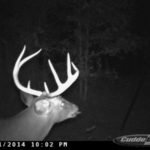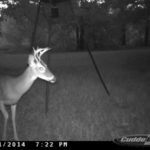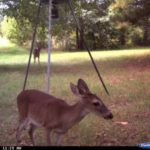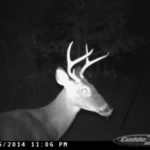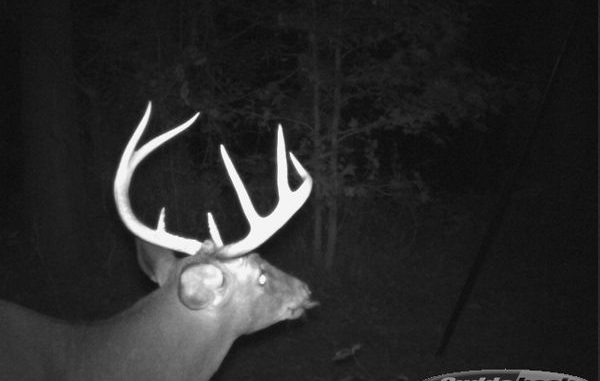
The last set of photographs is from Area 2 in Desoto Parish. The habitat is mixed pine/hardwood, with no agriculture but some winter pastures for cattle and lots of oil and gas pipelines that create a lot of edge.
Browse availability is good, and this habitat has produced trophy deer.
No. 1
No doubt this is an adult buck: It has four points on the right and three points on the left, with good main beams and heavy antler mass.
The deer is not going to score high due to the lack of symmetry. I do not like the fact that the left beam growth showed no sign of a G-3, a trait it might continue to exhibit in later years.
Shoot the buck, and get some data to better document body growth and antler development.
No. 2
This is a very nice yearling buck with an impressive first-year set of antlers.
This young buck has lots of potential —shame on you, should you pull the trigger on this deer.
The high-end deer in the young age classes of bucks should always be on the no-shoot list.
Note that the buck has a neck like an adult doe; also note the straight body lines.
No. 3
The date of the photo is Oct. 1, so bow season has open. This young deer has just walked into your shooting zone. But it is obvious that it is a nubby buck — a 6-month-old male fawn.
While the world would not stop spinning should you drill it, save the tag for another deer.
In Area 2, the nubs on the male fawns are visible and will continue to grow larger and become more obvious. In Areas 1,4 and 6, on Oct. 1 the nubs of the male fawns are not distinct at all. This is a key difference in the deer herds with early breeding and late breeding. The nubs on male fawns in the late breeding areas generally become visible in December.
While it is good to harvest some female fawns from the population, many hunters are not able to tell the difference between male and female fawns, and some programs prohibit hunters from shooting fawns to avoid harvesting male fawns.
No. 4
Is this a young 2-year-old buck or a low end 3-year-or-older buck?
Growth trends based on harvest data suggest it is a 2-year-old due to beam length and lack of antler mass. Most of the 2-year-olds on this habitat are 6-pointers or small 8.
Let it go another year, and see what it does.
